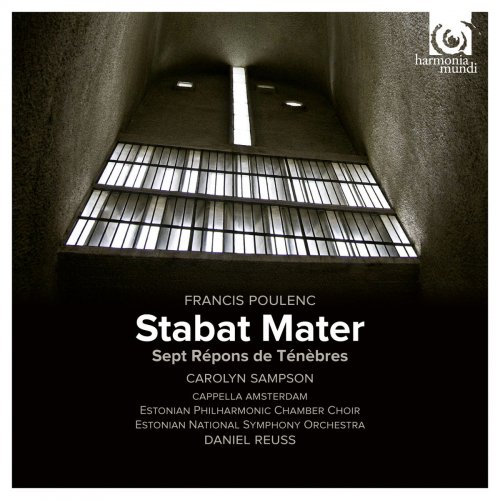Carolyn Sampson, Cappella Amsterdam & Daniel Reuss - Poulenc: Stabat Mater (2014) [Hi-Res]

Artist: Carolyn Sampson, Cappella Amsterdam, Daniel Reuss
Title: Poulenc: Stabat Mater
Year Of Release: 2014
Label: harmonia mundi
Genre: Classical
Quality: flac lossless / flac 24bits - 96.0kHz
Total Time: 01:02:08
Total Size: 288 / 1114 mb
WebSite: Album Preview
TracklistTitle: Poulenc: Stabat Mater
Year Of Release: 2014
Label: harmonia mundi
Genre: Classical
Quality: flac lossless / flac 24bits - 96.0kHz
Total Time: 01:02:08
Total Size: 288 / 1114 mb
WebSite: Album Preview
---------
01. Sept Répons des Ténèbres, FP 181: I. Una hora non potuistis vigilare mecum
02. Sept Répons des Ténèbres, FP 181: II. Judas mercator pessimus
03. Sept Répons des Ténèbres, FP 181: III. Jesum tradidit impius
04. Sept Répons des Ténèbres, FP 181: IV. Caligaverunt oculi mei
05. Sept Répons des Ténèbres, FP 181: V. Tenebrae factae sunt
06. Sept Répons des Ténèbres, FP 181: VI. Sepulto Domino
07. Sept Répons des Ténèbres, FP 181: VII. Ecce quomodo moritur justus
08. Stabat Mater pour soprano, chœur mixte & orchestre: I. Stabat mater dolorosa
09. Stabat Mater pour soprano, chœur mixte & orchestre: II. Cujus animam gementem
10. Stabat Mater pour soprano, chœur mixte & orchestre: III. O quam tristis et afflicta
11. Stabat Mater pour soprano, chœur mixte & orchestre: IV. Quae moerebat et dolebat
12. Stabat Mater pour soprano, chœur mixte & orchestre: V. Quis est homo, qui non fleret
13. Stabat Mater pour soprano, chœur mixte & orchestre: VI. Vidit suum dulcem natum
14. Stabat Mater pour soprano, chœur mixte & orchestre: VII. Eja mater, fons amoris
15. Stabat Mater pour soprano, chœur mixte & orchestre: VIII. Fac Ut Ardeat Cor Meum
16. Stabat Mater pour soprano, chœur mixte & orchestre: IX. Sancta mater, istud agas
17. Stabat Mater pour soprano, chœur mixte & orchestre: X. Fac ut portem Christi mortem
18. Stabat Mater pour soprano, chœur mixte & orchestre: XI. Inflammatus et accensus
19. Stabat Mater pour soprano, chœur mixte & orchestre: XII. Quando corpus morietur
Poulenc’s 'Stabat Mater', which he described as a ‘requiem without despair’, was written in 1950 following the death of Christian Bérard who designed the sets for Cocteau’s films and plays and was a leading figure of 1940s Paris. This masterly work, dedicated to the Virgin of Rocamadour, gives pride of place to the chorus and clearly shows its line of descent from the French grands motets. On completing it, Poulenc wrote to Pierre Bernac: "It’s good, because it’s completely authentic".
From the time of his pilgrimage to Rocamadour in 1936, Poulenc's religious output was filtered through his Catholic interpretation of the world and his personal trajectory. The 'Stabat Mater' is no exception to this rule, in that it associates the events and circumstances of his own life with the drama of the Gospels. It identifies the three figures of Christ, the Virgin and the Faithful Disciple with biographical figures: Bérard, Poulenc, and the latter’s lover Lucien Roubert, whom he was to refer to as ‘the secret’ of the 'Stabat Mater' and 'Dialogues des Carmélites'.
In December 1959 Leonard Bernstein commissioned a new work from Poulenc for the New York Philharmonic Orchestra. He chose to write the 'Sept Répons des Ténèbres' (Seven Tenebrae Responses) for treble soloist, a chorus of boys’ and men’s voices and symphony orchestra. The posthumous first performance took place on 11 April 1963 at Philharmonic Hall (now Avery Fisher Hall) under the direction of Thomas Schippers. Poulenc had insisted on these all-male vocal forces, but, 50 years after his death, it is important to allow for more widespread performance of this fascinating score which has too long languished in the shadows.
![VA - Who Loves You? A Tribute To Jaco Pastorius (2003) [Hi-Res] VA - Who Loves You? A Tribute To Jaco Pastorius (2003) [Hi-Res]](https://www.dibpic.com/uploads/posts/2025-12/1766570996_r8byrhmtd2qlc_600.jpg)







